Monsteras
BackMonsteras are amazing indoor plants that are enjoying a surge in popularity. There are a few different species to choose from with the most popular being the swiss cheese plant (Monstera deliciosa). It has huge glossy green leaves with signature ‘cheesy’ holes (hence the common name). It’s perfect for adding drama and instantly greening up the home – truly a statement piece!
If you’re short on space then there are still monsteras for you. Look for smaller forms, like Monstera ‘Tauerii’ or Monstera adansonii, which is a sweet heart-shaped vining or trailing plant.
How to Grow Monsteras
Monsteras are native to rainforests of central and south America. They start out on the forest floor and find their way to light by climbing and clinging onto trees with their aerial roots. To help them thrive in your home, mimic this by positioning them in a bright room but out of direct sunlight. They can handle direct morning sun but hot afternoon sun will burn their leaves.
Monsteras are easy-going when it comes to soil. All they need is a good quality potting mix that drains well. Some people add perlite and orchid bark for extra drainage and aeration but it’s not necessary unless you’re prone to overwatering your indoor plants. Water in new plants with eco-seaweed to help them settle and reduce transplant shock.
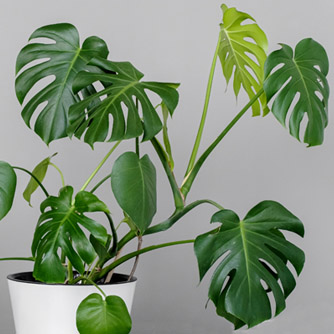
The large growing Monstera deliciosa
The large leaf monsteras are natural climbers and should be given a moss pole or trellis to grow up. This can also help increase the size of the leaves which in turn encourages the appearance of more holes. If your plant becomes too unruly, use several stakes to keep it in place or consider pruning it back (see further below). For smaller leaved vines, you can allow them to just trail about or provide them with a moss pole to climb.
When it comes to watering monstera should be kept on the drier side. Overwatering can cause root rot so allow the top few centimetres of potting mix to dry out before next watering.
If you find the leaves go floppy, the potting mix may have become water repellent and is not absorbing moisture when you water. Apply eco-hydrate to fix the issue. If your plant has been in the same potting mix for several years then it might be compaction that’s the issue so it’s time to repot with a fresh mix.
In warmer climates monsteras can be grown outdoors in protected positions.
Fertilising and Maintenance of Monsteras
Feed monsteras once a fortnight in the warmer months with OCP eco-seaweed and OCP eco-aminogro. This will ensure fast growth and lots of healthy green foliage.
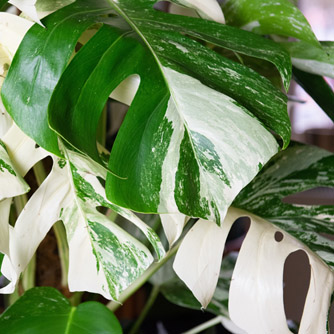
Variegated monsteras like this M. deliciosa ‘Albo-Variegata’ are highly sought after
Repot every couple of years to allow the roots to spread in a bigger pot and to freshen up the mix. For the large growing monsteras don’t let the root ball grow beyond a 500mm pot. In larger pots the plant will become quite top heavy and difficult to manage. Once it reaches the 500mm pot size, give it an annual root prune to help maintain the health and vigour of the plant. To prune, simply remove from the pot and shave a couple of centimetres off the entire root ball. Repot into fresh potting mix and water in with eco-seaweed. Repotting and root pruning should be done during the warmer months.
Pruning and Propagating
If plants become too wild, simply prune stems back to your desired size. Simple really 😊
To propagate new plants use secateurs and cut off a piece of the main stem just below a leaf node (the bump along the stem, where a leaf is produced). Place the cutting into water, ensuring the node is submerged and regularly top it up with fresh water. After 4-6 weeks, you should see new roots forming. Once they’re 10-15cm long, plant it into a small pot and water in with eco-seaweed.
Pests and Diseases of Monstera
- Scale – may be found on the undersides of leaves or along stems. Spray with botanical oil spray.
- Mealybugs – they love to hide in tight crevices and on the undersides of leaves. Spray thoroughly with OCP eco-neem.
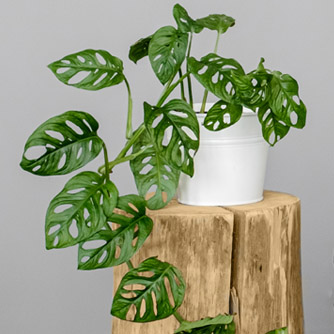
The smaller growing Monstera 'adansonii can be left to trail or climb if given a pole
- Thrips – these tiny insects eat away at the surface of the leaf, leaving discoloured patches. They can often be one of the reasons new leaves don’t unfurl. Spray with an organic insecticide.
- Fungus gnats – if these annoying pests are spotted flitting around your plant then treat the potting mix with a drench of OCP eco-neem. They love moisture so try to go longer before you water again. A repeat drench of OCP eco-neem maybe needed a week later.
- Brown leaves – browning edges on leaves are a sign of low humidity. To help increase humidity, group plants closer together or and place a shallow bowl of water around plants. Top up regularly as water evaporates.
- Brown spots or markings with yellow halo – a sign that the plant is overwatered and root rot is setting in. Stop over-watering and allow the soil to dry. If necessary, remove plant from existing soil, prune any blackened and diseased roots, pot into fresh soil and water in with eco-seaweed.
Varieties of Monsteras
There are many different monstera species and cultivars to choose from. Some are easier to find, while others have been dubbed ‘unicorns’ due to their rare and generally expensive nature.
Swiss cheese plant or fruit salad plant (Monstera deliciosa)
The most common form of monstera and much admired for its very large glossy leaves with holes known as fenestrations. It loves to climb so help it along with a moss pole or trellis. Overtime, the aerial roots may become elongated and spill over the sides of the pot – if you find this unsightly, simply trim them off. Otherwise leave them as it adds to their drama. A smaller form call M. ‘Tauerii’ is also available.
If you like variegation, look for ‘Thai Constellation’, which can be found in nurseries. A warning though as it does come with a hefty price tag, however, it’s still cheaper than rare and expensive Monstera deliciosa ‘Albo-Variegata’ or Monstera deliciosa f. borsigiana.
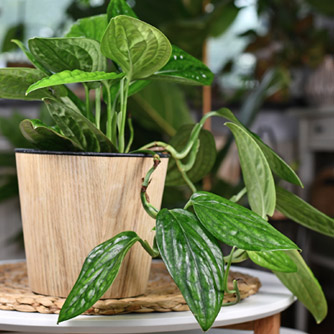
Monstera 'Peru' is a smaller growing plant that benefits from extra humidity
Swiss cheese vine (Monstera adansonii)
This is the ideal houseplant for those wanting the jungle vibe of monsteras but without the size. The leaves are more delicate and ‘cheesier’. They will get larger in size when exposed to more light but never huge like Monstera deliciosa. Allow the vines to trail over the sides or provide a moss pole for them to climb.
Monstera siltepecana
Similar in size and appearance to M. adansonii, except the heart-shaped leaves are beautifully patterned silver and deep bluey green. It’s a stunning plant, especially when multiple vines are trailing from a single pot. As the plant matures, it may form holes along the leaf midrib, but they are often seen without them.
Monstera ‘Peru’
This vining climber has attractive dark glossy green crinkly leaves and is a highly sought-after collector’s item. It requires more care than other monsteras needing extra drainage (via perlite and orchid bark) and a moderate to high level of humidity. While they can grow as trailing plants, it’s best to allow them to grow up a moss pole or totem.
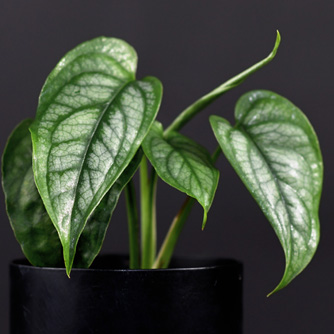
Another less common monstera is M. siltepecana


